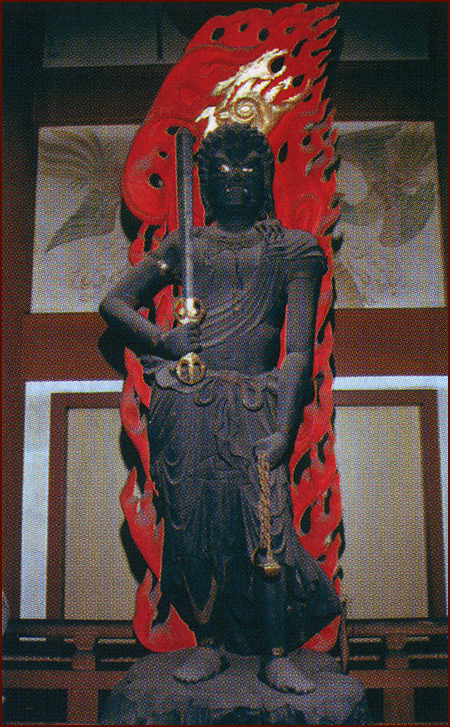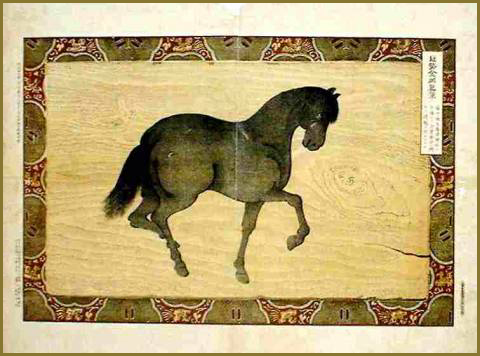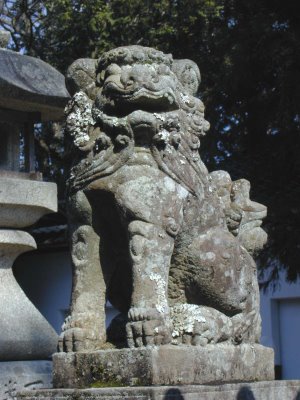[ . BACK to DARUMA MUSEUM TOP . ]
. Famous Places and Powerspots of Edo 江戸の名所 .
::::::::::::::::::::::::::::::
:::::::::::::::::::::::::::::::::::::::::::::::::::::::::::::::::::::::::::::::::::::::::::::::::::::::::::::::::::::::::::::::::::::::::::::::::::::::
Kamimeguro, Kami-Meguro 上目黒
. Meguro 目黒区 Meguro-ku, Meguro ward .
Meguro was home to the hawks and falcons hunting grounds (takajo 鷹所)of the Shogun, first developed by Tokugawa Ieyasu himself, because he was an avid hunter.

. 幕府放鷹制度 Bakufu government rules about takagari 鷹狩 .
..............................................................................................................................................
- quote
Kami-Meguro - The Shogun's Hawk-Hunting Grounds
A long procession of men streams down the country road. Today I am going to take you along with Matsudaira-dono and a large party of his retainers to the western fringe of the city. The shogun is on one of his annual hawk-hunting expeditions, and has asked Matsudaira-dono to come along for a few days and take part.
The shogun has seven taka-jo (hawking estates) strategically located in a ring around the city. From these estates, it is possible to get quickly to any of the major farming villages and small towns in the greater Edo vicinity. The location of hawk-hunting estates is very important, and the first shogun, Ieyasu, spent a great deal of time in planning them. The one that you are going to, in Meguro, is well placed at the center of a busy farming region, and it can serve as a base of operations to visit all of the farming villages in the area. It might seem strange that the head of the bakufu (government) pays so much attention to hawking, but this is because hunting has other roles besides simply a pastime.
Hawking has been a popular sport among the nobles and high-ranking samurai for many centuries. At first, however, it simply involved an overnight outing to the countryside, where each of the participants would show off the hunting skills of the eagles and hawks that they raised and trained. However, during the sengoku jidai (the age of warring states), hawk hunting began to take on several other purposes. Hawk hunting expeditions would often last for months at a time, and the daimyo and high-level samurai would cover wide areas of their domains during their hunt.
The leaders discovered that hawk-hunting gave them a convenient excuse to show up unannounced in villages throughout their territory. This allowed them to see for themselves how daily life was in the countryside they ruled, and make sure that everything was all right in the area. If farmers were cheating on their taxes, he would often find evidence when making an unexpected visit. On the other hand, if the local administrators were treating the local people unfairly, the daimyo could ask the people about their conditions as he passed through the villages on one of his hawk-hunting expeditions. However, since the daimyo was just "out hunting", the people would not have any reason to complain, or feel upset that he was spying on them.
When Tokugawa Ieyasu became shogun, he made hawking a very formal part of his yearly activities. He set up hawk-hunting manors throughout his own territory, and encouraged the other daimyo to do so as well. Several times a year he would go on expeditions, and in addition to his hunting companions and hawk-tenders, he also brought along accountants and clerks to check carefully all the local tax and production records of the towns they travel through during their hunts. The shipments of tax rice could be checked and compared with the size of the fields in the town, to see if everyone was paying the proper amount.
In addition, Ieyasu passed a law that allows any farmer or peasant to come forward and make a complaint or petition while the shogun is travelling through their village on a hawk hunt. This way, if the local people have a complaint about how the local government officials are treating them, they can go directly to the shogun with the problem, and don't have to worry that the local leaders might punish them for speaking out. All of Ieyasu's successors have continued the tradition of hawk hunting. The current shogun goes out hawking about six or seven times a year, usually for at least a week.
Although hawking expeditions involve quite a lot of "unofficial business", they are also a chance for the shogun to relax from the dull routine of life at the castle. The shogun is the most powerful man in Japan, but he has to answer to the demands of many different groups -- the Imperial court in Kyoto, each of the local daimyo, the leaders of major temples and shrines throughout the country, the local administrators in Edo, and so on. Back in Ieyasu's day, these demands were still limited, but nowadays the shogun's life seems to be one meeting after another. Hawk hunting gives him a chance to get out of the city and away from all the long, formal meetings. A chance to enjoy the open countryside, fresh air and sunshine!

- 名所江戸百景 -
元不二(元富士)"Old Mount Fujisan" and 新冨士 "New Mount Fujisan"
Hawk hunting is not very strenuous for the shogun and the daimyo who accompany him. However, their main purpose in going on a hawking expedition, in addition to the opportunity to relax and enjoy nature, is to view the farms and villages in the area and study the landscape. Back in the days when daimyo were still fighting one another, the expedition would include many scouts and spies, who would try to find locations for a strong fort, or try to see what was going on in neighboring territories. Nowadays, the men are mainly looking for fields of crops that the farmers did not mention when paying their taxes, or examining new areas where the land might be cleared and made suitable for farming.
Each of the shogun's seven hawking estates, or taka-jo ("taka" means "hawk") is managed by a staff of several hawk supervisors (taka-mi). Their job is to raise the hawks and train them to hunt for small birds and rabbits. They also keep an eye on the local villages and make sure they follow the rules. There are many special rules for the areas surrounding the hawk-hunting estates. For example, local people living near the estates are not allowed to have dogs or cats as pets. They also have to get special permission if they need to do any building work, and usually the permission is only granted at certain times of the year when the noise will not disturp the game birds and animals that live in the area. Most of these rules are intended to ensure that there is plenty of game to hunt. Because of these strict rules, the areas of farmland immediately surrounding the hawking manors are filled with birds and game. In fact, as your company crosses the fields and meadows, flocks of game birds can be seen even right near the homes of the local villagers.
The shogun and his companions ride their horses at the front of the long procession. Their hawks are perched on their arms, the head covered by a tiny hood until it is time for the bird to hunt. When the lead riders reach a clearing that looks like a good place for hunting, they dismount and then send a signal back to the servants and assistants who are following them. The assistants then fan out through the woods and begin moving slowly toward the place where the shogun and his companions are waiting.

富士山麓の鷹狩り - 喜多川歌麿 Kitagawa Utamaro
The birds and rabbits in the woods run away from the servants, who make a lot of noise as they walk through the woods. The line of servants continues to move toward the clearing, and eventually the game birds have to fly out into the open to get away. As soon as a game bird flies out into the clearing, one of the riders releases his hawk. The hawk flies swiftly after its prey, soaring into the sky and then wheeling to strike. The hawks are well trained, and they rarely miss a kill. The hawk soars like an arrow towards its prey, striking quickly and bringing down its victim. The assistants collect the dead birds or rabbits once the hawk has made the kill, and put them in a large sack. The game that the hawks catch today will be served to the shogun and his companions at dinner tonight.
The hunt covers a wide area of fields and woodland, stopping many times both to hunt and to speak to local farmers and gather information. After a long day of jogging over hills and fields to keep up with the men on horseback, the guards and servants are exhausted. While the shogun, and the other high-ranking officials dine in the taka-jo's main house, the servants and retainers will roast quail or ducks over the fire. After dinner, they will sit by the fire, lie back smoking their pipes, and gaze at the sparkling stars before dropping off to sleep by the fire.
- source : Edomatsu
:::::::::::::::::::::::::::::::::::::::::::::::::::::::::::::::::::::::::::::::::::::::::::::::::::::::::::::::::::::::::::::::::::::::::::::::::::::::::::::::::::::::::::::::::::::

- reference source : wheatbaku.exblog.jp -
Many shoguns liked to go for takagari 鷹狩り hunting with hawks and falcons. During these outings, they used to rest and eat outside.
These places were called (with the honorable 御 O at the beginning):
御腰掛 okoshikake, 御立寄所 otachiyorijo, 御仲休所, 御休憩所 okyusokujo - "resting place"
御膳所 ozenjo、御弁当所 obentojo - "place to eat"
御小休所 oshonbensho - "place to use a toilet"
The best known of these places are shrines and temples :
隅田村の木母寺 Sumida village, Mokubo-Ji - 木下川村の浄光寺 Kinegawa village, Joko-Ji
音羽町の護持院 Otowa village, Goji-In - 中目黒の祐天寺 Naka-Meguro, Yutenji
品川の東海寺 Shinagawa, Tofuku-Ji - 鈴ヶ森八幡 Suzugamori Hachiman - 深川の永代寺 Fukagawa, Eitai-Ji
亀戸村の亀戸天神・普門院 Kameido Tenjin, Fumon-In
千駄木の鷹部屋 Sendagi Falconry - 雑司ヶ谷の鷹部屋 Zoshigaya Falconry - 駒場の御用屋敷 Komaba Falconry
上中里村の御用屋敷 Kaminakamura Falconry - 小菅村の伊奈半左衛門屋敷 Kosuge village, estate of Ina Hanzaemon - 中川番所 Nakagawa Guard House
. Toofukuji 東福寺 Tofuku-Ji .
ozensho 御膳所 "place to eat" for the Shogun
. Mokuboji 木母寺と梅若丸伝説 Mokubo-Ji and Umewakamaru Legend .
::::::::::::::::::::::::::::::
:::::::::::::::::::::::::::::::::::::::::::::::::::::::::::::::::::::::::::::::::::::::::::::::::::::::::::::::::::::::::::::::::::::::::::::::::::::::


下目黒 (しもめぐろ) Shimomeguro - 葛飾北斎 Hokusai
:::::::::::::::::::::::::::::::::::::::::::::::::::::::::::::::::::::::::::::::::::::::::::::::::::::::::::::::::::::::::::::::::::::::::::::::::::::::::::::::::::::::::::::::::::::
- - - - - H A I K U and S E N R Y U - - - - -
. takagari 鷹狩 hunting with hawks and falcons .
falconry - ... hooyoo 放鷹(ほうよう)
takano 鷹野(たかの)open field with hawks
takajoo 鷹匠 (たかじょう) Takajo, keeper, trainer of the falcons and hawks
... takashi 鷹師(たかし)
- - kigo for all winter - -
naitogari 鳴鳥狩 ないとがり hunting and training with hawks
asa takagari 朝鷹狩(あさたかがり)
asatogari 朝鳥狩(あさとがり)、
oboegari 覚狩(おぼえがり)training the hawk
tomarigari 泊り狩(とまりがり)staying in the mountain (hut for training)
tomariyama, tomari-yama 泊り山(とまりやま)
kikisuedori 聞すえ鳥(ききすえどり)
misuedori 見すえ鳥(みすえどり)
suzuko 鈴子(すずこ) little bell
suzuko sasu taka 鈴子挿す鷹(すずこさすたか)
tsugi ootaka 継尾の鷹(つぎおのたか)
shirao no taka 白尾の鷹(しらおのたか)hawk with a white tail
shirafu no taka 白斑の鷹(しらふのたか)hawk with white spots
Hunting with hawks is done in winter, but the training of the animals starts in spring. They get a bell on one foot and have to learn how to hunt and come back to the master. Often the hawker and his animal stay in a mountain hut for a while together during this time.
- - kigo for late spring - -
:::::::::::::::::::::::::::::::::::::::::::::::::::::::::::::::::::::::::::::::::::::::::::::::::::::::::::::::::::::::::::::::::::::::::::::::::::::::::::::::::::::::::::::::::::::
. Japanese Legends - 伝説 民話 昔話 – ABC-List .
..............................
................................................................................................................
愛知県 Aichi 津島市 Tsushima
kitsune 狐 fox
The 尾張大納言 Lord of Owari
尾張大納言が津島で鷹狩りをしていた時、薬の調合のため狐の生肝を所望した。そこで餌指の市兵衛が狐を捕まえ、残りの肉と皮までもらいうけた。すると清洲にいた彼の妻にその狐が憑き、恨みを晴らそうとしたという。それを聞いた大納言は、狐は霊獣なので道理が通じると考え、家臣の真島権左衛門を派遣し、死すべき命を人間の薬のために殺したのだから喜ばしい事ではないかと狐を諭した。すると狐は我らのような畜類に、大君の厳命を頂けるのはありがたいと言って憑くのをやめたという。
ある時、夜更けより尾張の太守が鷹狩りに御出になった。すると山の奥より「申の歳申の月申の日に猿を殺した尾張殿はどこだ」という怪しい声がし、総勢が動けなくなった。そこで尾張太守は強気の士を呼びよせると、士は「何やつぞ」と叫びながら睨みつけると、妖怪は去ったと見えて夜が明けたようになり皆は正気に戻った。
..............................................................................................................................................
愛媛県 Ehime 温泉郡 Onsen district
. shichinin misaki 七人ミサキ Nananin Misaki Legends .
a group of persons who died in an accident or in unnatural circumstances
.......................................................................
- 西岡 Nichioka and 重信町 Shigenobu
Once a family of seven went hunting for hawks, (which was forbidden), and even ate the hawk. They were executed by chopping off their heads. Later if people walk by that ground, they will soon encounter some misfortune. The souls of the seven are now venerated at a small Hokora sanctuary as
七社権現 Shichisha Gongen - The Gongen Deities from Seven Shrines .
(See their photo in the link given above.)
..............................................................................................................................................
福岡県 Fukuoka 北九州市 Kita-Kyushu
gozutennoo 牛頭天王 at Ogura Yasaka Jinja
小倉八坂神社の祭礼の創始についての伝説。細川越中守忠興が鷹狩のとき、不動山で休息した。そこに1つの石祠はあったが、忠興が携えた杖で祠の扉を開けると1羽の霊鷹が中より飛び出し忠興の両目を蹴った。痛みがひどく直ちに帰邸し手当てをしたが直らない。これは牛頭天王の神罰と恐怖して1社を建立し祭りを興行し神楽湯立をするとお願込をして漸く右目だけ治った。それでももう片目が治らないので神前で能興行をすると祈ったところ漸く治った。
..............................................................................................................................................
栃木県 Tochigi
下野の国の阿曽沼に鷹を使う者がいた。ある時鷹狩りをして、鴛の雄を取って帰った。その夜の夢に品の良い女が現れて、怨み深い様子で泣いて、「なぜ私の夫を殺したのか」という。「そんなことはしていない」というと、「確かに今日召し取った」といい、歌を詠じて飛び立つのを見ると鴛の雌であった。驚いて朝見れば、昨日の雄と嘴をあわせて雌が死んでいた。男はそれを見て発心して出家した。
.
殺生を好んで鷹を使うものがいた。ある時鷹狩りの帰りに鴛の雄を捕まえ餌袋に入れて帰った。その夜、夢にうつくしい女房が現れ、夫を殺したと嘆いた。そのようなことはしていないと否定したが、女房は和歌を詠んでふっと立ち上がった。それを見ると鴛の雌であった。驚いて哀れに思っていると朝になり、昨日の雄と嘴を食い合って死んでいる雌がいた。これを見て発心し出家した。
..............................................................................................................................................
東京都 Tokyo
In Edo in the district 通銀町二丁目 lived a merchant called 堯順 Takayasu. He had employed the child of a hunter who was responsible to provide food for the Falconry in Hachioji. But this child died of an epidemy. They washed the body and wanted to cut its hair, but the sissors did not cut a thing. Then Takayasu looked closer, he saw a beak of a bird had grown at the head, almost as hard as a stone. This was around the year 1680.
-
. samuhara サムハラ divine amulets .
..............................................................................................................................................
- reference : Nichibun Yokai Database -
9 legends about 鷹狩 takagari (00)
:::::::::::::::::::::::::::::::::::::::::::::::::::::::::::::::::::::::::::::::::::::::::::::::::::::::::::::::::::::::::::::::::::::::::::::::::::::::::::::::::::::::::::::::::::::

- - - To join me on facebook, click the image !
:::::::::::::::::::::::::::::::::::::::::::::::::::::::::::::::::::::::::::::::::::::::::::::::::::::::::::::::::::::::::::::::::::::::::::::::::::::::::::::::::::::::::::::::::::::
. Famous Places and Powerspots of Edo 江戸の名所 .
. Doing Business in Edo - 商売 - Introduction .
. shokunin 職人 craftsman, craftsmen, artisan, Handwerker .
. senryu, senryū 川柳 Senryu poems in Edo .
. densetsu 伝説 Japanese Legends - Introduction .
[ . BACK to DARUMA MUSEUM TOP . ]
[ . BACK to WORLDKIGO . TOP . ]- - - - - #kamimeguro #takagari - - - -
::::::::::::::::::::::::::::::
::::::::::::::::::::::::::::::::::::::::::::::::::::::::::::::::::::::::::::::::::::::::::::::::::::::::::::::::::::::::::::::::::::::::::::::::::::::
--
Posted By Gabi Greve to Edo - the EDOPEDIA - on 10/12/2015 09:22:00 am



















































